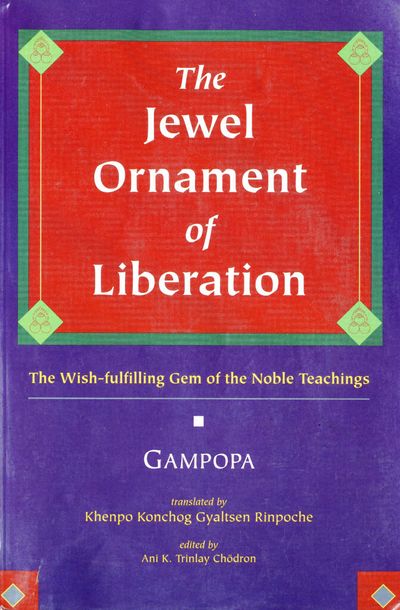- Foreword by His Holiness the 14th Dalai Lama13
- Acknowledgments14
- Translator's Introduction15
- Homage44
- Introduction45
- Part 1: The Primary Cause 47
- Chapter 1: Buddha-Nature 49
- I. Disconnected Family 50
- II. Indefinite Family 51
- III. Hearer Family 51
- IV. Solitary Realizer Family 51
- V. Mahayana Family53
- A. Classification53
- B. Definition53
- C. Synonyms53
- D. Superiority54
- E. Causal Characteristics54
- F. Marks54
- Part 2: The Working Basis 57
- Chapter 2: The Precious Human Life 59
- I. Leisure 59
- II. Endowment 60
- III. Trusting Faith 65
- IV. Longing Faith 65
- V. Clear Faith 65
- Part 3: The Contributory Cause 67
- Chapter 3: The Spiritual Master 69
- I. Reason 69
- II. Classification 71
- III. Characteristics of Each Classification 72
- IV. Method 73
- V. Benefits 75
- Part 4: The Method 77
- Introduction to Part 4 79
- Antidote to Attachment to this Life 81
- Chapter 4: Impermanence 83
- I. Classification 83
- II. Method of Meditation 84
- III. Beneficial Effects of Meditation 91
- Antidote to Attachment to Samsara's Pleasure93
- Chapter 5: The Suffering of Samsara 95
- I. All-Pervasive Suffering 95
- II. The Suffering of Change 96
- III. The Suffering of Suffering 97
- A. Hell Realm 97
- B. Hungry Ghost Realm 102
- C. Animal Realm 102
- D. Human Realms 103
- E. Demi-God Realm 108
- F. God Realm 108
- Chapter 6: Karma and its Result 111
- I. Classification 112
- II. Primary Characteristics of Each Classification 112
- A. Non-Meritorious Karma and its Result112
- 1. Taking Life112
- 2. Stealing113
- 3. Sexual Misconduct113
- 4. Lying114
- 5. Divisive Speech114
- 6. Harsh Words114
- 7. Idle Talk115
- 8. Covetousness115
- 9. Harmful Thought116
- 10. Wrong Views116
- B. Meritorious Karma and Result117
- C. Karma and Result of Unshakable Meditative Concentration118
- A. Non-Meritorious Karma and its Result112
- III. Ascription 119
- IV. Strict Result 120
- V. Increase from the Small 120
- VI. Inevitability 121
- Antidote to Attachment to the Pleasure of Peace 123
- Chapter 7: Loving-Kindness and Compassion 125
- I. The Practice of Loving-Kindness 125
- A. Classification126
- B. Object126
- C. Identifying Characteristic126
- D. Method of Practice126
- E. Measure of the Practice129
- F. Qualities of the Practice129
- II. The Practice of Compassion 129
- A. Classification130
- B. Object130
- C. Identifying Characteristic130
- D. Method of Practice130
- E. Measure of the Practice131
- F. Qualities of the Practice131
- I. The Practice of Loving-Kindness 125
- Antidote to Not Knowing the Method of Practice for Achieving Buddhahood 133
- Introduction to the Antidote to Not Knowing the Method of Practice 135
- Chapter 8: Refuge and Precepts 137
- I. Foundation 137
- A. Mahayana Family138
- B. Taking Refuge in the Three Jewels138
- 1. Classification139
- 2. Working Basis139
- 3. Objects139
- 4. Time141
- 5. Motivation141
- 6. Ceremony141
- 7. Activities143
- 8. Training143
- 9. Beneficial Effects143
- C. Pratimoksa Precepts 144
- I. Foundation 137
- Chapter 9: Cultivation of Bodhicitta 147
- II. Essence 147
- III. Classification 147
- IV. Objectives 151
- V. Cause151
- VI. From Whom You Receive It152
- VII. Method (Ceremony)153
- VIII. Beneficial Effects168
- IX. Disadvantages of Losing It171
- X. The Cause of Losing It171
- XI. The Method of Repairing172
- Chapter 10: Training in Aspiration Bodhicitta 173
- XII. Training173
- A. Training in Aspiration Bodhicitta173
- 1. Not Forsaking Sentient Beings from One's Heart173
- 2. Recollecting the Beneficial Effects of Bodhicitta174
- 3. Gathering the Two Accumulations175
- 4. Practicing the Enlightened Mind175
- 5. Rejection of the Four Unwholesome
- Deeds and Acceptance of the Four Wholesome Deeds176
- A. Training in Aspiration Bodhicitta173
- XII. Training173
- Chapter 11: Training in Action Bodhicitta 179
- B. Training in Action Bodhicitta179
- 1. Definite Number180
- 2. Definite Order180
- 3. Characteristics181
- 4. Definition181
- 5. Division181
- 6. Grouping182
- B. Training in Action Bodhicitta179
- Chapter 12: The Perfection of Generosity 183
- I. Reflection on the Faults and Virtues183
- II. Definition185
- III. Classification185
- IV. Characteristics of Each Classification185
- V. Increase 191
- VI. Perfection191
- VII. Result192
- Chapter 13: The Perfection of Moral Ethics 195
- I. Reflection on the Faults and Virtues195
- II. Definition197
- III. Classification197
- IV. Characteristics of Each Classification197
- V. Increase202
- VI. Perfection202
- VII. Result202
- Chapter 14: The Perfection of Patience 205
- I. Reflection on the Faults and Virtues205
- II. Definition207
- III. Classification207
- IV. Characteristics of Each Classification207
- V. Increase211
- VI. Perfection211
- VII. Result211
- Chapter 15: The Perfection of Perseverance 213
- I. Reflection on the Faults and Virtues213
- II. Definition214
- III. Classification216
- IV. Characteristics of Each Classification216
- V. Increase218
- VI. Perfection218
- VII. Result218
- Chapter 16: The Perfection of Meditative Concentration 219
- I. Reflection on the Faults and Virtues219
- II. Definition220
- III. Classification229
- IV. Characteristics of Each Classification229
- V. Increase230
- VI. Perfection230
- VII. Result231
- Chapter 17: The Perfection of Wisdom Awareness 233
- I. Reflection on the Faults and Virtues233
- II. Definition235
- III. Classification235
- IV. Characteristics of Each Classification235
- V. What is to be Known236
- VI. What is to be Practiced247
- VII. Result255
- Chapter 18: The Aspects of the Five Paths 257
- I. Path of Accumulation257
- II. Path of Application258
- III. Path of Insight259
- IV. Path of Meditation259
- V. Path of Perfection260
- Chapter 19: The Ten Bodhisattva Bhumis 263
- I. Definition264
- II. Significance of the Bhumis264
- III. The Reason Their Classification Is Tenfold264
- A. First Bhumi265
- B. Second Bhumi267
- C. Third Bhumi268
- D. Fourth Bhumi269
- E. Fifth Bhumi270
- F. Sixth Bhumi271
- G. Seventh Bhumi272
- H. Eighth Bhumi273
- I. Ninth Bhumi274
- J. Tenth Bhumi275
- K. Buddhahood277
- Part 5: The Result 279
- Chapter 20: Perfect Buddhahood 281
- I. Nature281
- II. Significance of the Name286
- III. Classification287
- IV. Definition287
- V. Reason There Are Definitely Three Kayas288
- VI. Characteristics of the Three Kayas288
- VII. Special Traits292
- Part 6: The Activities 295
- Chapter 21: Activities of the Buddha 297
- I. Activities of the Body297
- II. Activities of Speech298
- III. Activities of Mind299
- Appendices 303
- Appendix A: Dharma Lord Gampopa 305
- Section 1: A Brief Account of Dharma Lord Gampopa's Life305
- Section 2: Miraculous Manifestations323
- Section 3: Gampopa's Method of Teaching325
- Appendix B: Stories Referred to in the Text 333
- Sudhana335
- Sadaprarudita340
- King Anala348
- Maudgalyayana351
- Sangharakshita357
- Nawa Chewari362
- Old Born366
- King Krika's Daughters368
- Mahadatta371
- King Bala Maitreya379
- Angulimala381
- Udayana385
- Nanda388
- Ajatashatru393
- Appendix C: Outline of the Text 397
- Appendix D: A Brief Biography of the Translator 413
- Titles of Works Quoted 417
- Glossary427
- Notes437
- Bibliography459
- Index467



